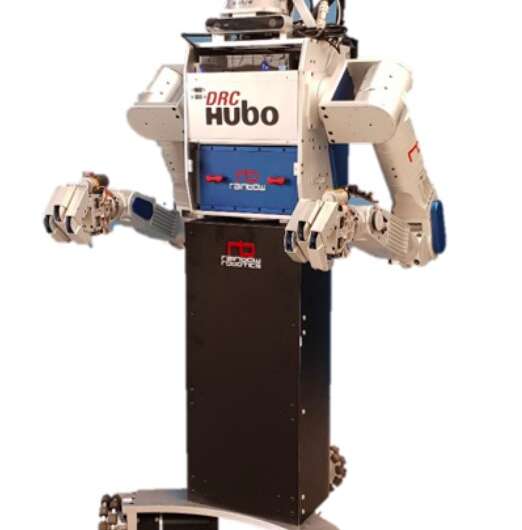January 20, 2020 feature
M-Hubo: A wheeled humanoid robot to assist humans with simple daily tasks

Researchers worldwide are now training robotic agents to assist humans in a variety of manual tasks, including cooking and moving objects. While many of these robots have achieved promising results, most of them are still unable to complete the tasks assigned to them as quickly as a human being would.
For instance, most robots trained to fetch objects and carry them to humans are rather slow in fulfilling user requests, which makes them difficult to deploy on a large scale. This is mainly because training artificial agents on manipulation tasks can be very challenging, as these tasks tend to involve both perception and planning, which together can prevent collisions while the robot is moving in its surrounding environment.
Researchers at the Korea Advanced Institute of Science and Technology (KAIST) have recently created M-Hubo, a wheeled humanoid robot that completes simple daily tasks faster than other previously developed robots. The new robot, presented in a paper prepublished on arXiv, may prove particularly useful in helping the elderly and individuals who find it difficult to walk around the house or complete basic chores independently.
"We developed a new, fully autonomous robotic butler system for a wheeled humanoid," the researchers wrote in their paper. "In this work, we focus on one particular application for the service robot: fetching and serving drinks at comparable human-like speeds in a static indoor environment."
To successfully fetch a given object and hand it to a human user, service robots need to first be able to sense what is happening in their surrounding environment in real time, generating motion trajectories that prevent collisions with nearby objects. This can be very difficult to achieve, particularly in situations where the environment is dynamic (i.e., continuously changing) or when its structure is unknown to the robot.
To address this challenge, the research group at KAIST developed a new design strategy that entails the integration of a 3-D object detection pipeline with a kinematically optimal manipulation planner. This unique strategy was found to decrease the amount of time needed by the M-Hubo robot to fetch a beverage for a human user, increasing the speed at which it processed information about its surroundings and planned trajectories.
"The proposed system performed at 24 percent of the speed a human needs to fulfill the same task," the researchers wrote in their paper. "The system demonstrated a high success rate of 90 percent in our environment setup, but reflected a reduced performance of 80 percent success rate in a more dynamic public exhibition due to environmental variations during run-time."
The researchers at KAIST have recently evaluated and showcased their robotic butler system at a public exhibition. In the future, the design strategy at the core of M-Hubo could inform the development of new service robots that can complete simple tasks faster and more efficiently. In addition, once it is perfected, M-Hubo could prove to be a particularly useful tool for providing basic assistance to the elderly, as well as other individuals with limited mobility.
In their next studies, the researchers would like to add a localization component to the robot, as this would allow it to fetch objects quickly both in static and dynamic environments. In order to achieve this, they would need to equip the robot with a tool for dynamic path planning and a high-level task planner, substituting the simple finite state machine (FSM) that they used in the demo version of M-Hubo.
"In addition, learning strategies could be utilized in the future to reduce failures, uncertainties, and unsafe states, to ultimately increase success rate," the researchers wrote. "Lastly, the overall execution time can be further reduced even in dynamic environments by incorporating faster sampling motion planners."
More information: Fast perception, planning, and execution for a robotic butler: wheeled humanoid M-Hubo. arXiv:2001.00356 [cs.RO]. arxiv.org/abs/2001.00356
© 2020 Science X Network




















